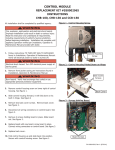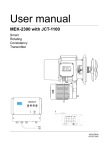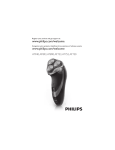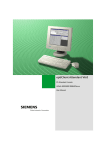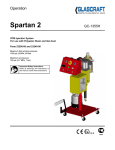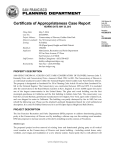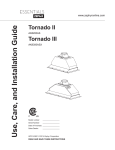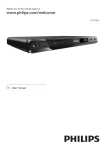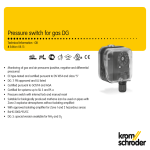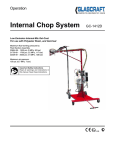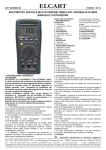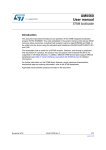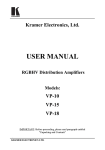Download Silicone Sealants Manual PERFECT JOINTS
Transcript
SILICONE SEALANTS MANUAL PERFECT JOINTS MADE EASY CREATING TOMORROW’S SOLUTIONS Where to Find What Introduction Applications Benefits Joint Design Work Steps Types of Joints RTV-1 Silicone Sealants Standards and Quality WACKER at a Glance EXPECT AS MUCH FROM A SILICONE SEALANT AS YOU DO OF YOURSELF: THE BEST 2 3 4 6 8 10 12 20 22 23 Applications WACKER Silicone Sealants – General-purpose and tailored solutions – Broad application range – Consistently high quality – Easy to process – Technical support Versatile Silicone Sealants There are things that make you wonder how you ever managed without them. Prime examples are silicone sealants, which have developed into indispensable, versatile products for an extremely broad application range over some fifty years. Whether on building sites, in the field of sanitary applications and fittings, window construction, metal or plastic construction, in the household or DIY sectors – silicone sealants are used everywhere. They seal joints reliably and ensure the weatherproof joining of structural components. At the same time, silicone sealants prevent construction elements locking together. They contribute to long-lasting quality, obtained in a particularly quick and easy manner. WACKER Represents Quality Nothing is perfect. That is why WACKER is constantly improving its silicone sealants. Today’s high-tech silicone sealants have to meet the strictest specifications: optimum adhesion, extreme aging resistance to outside influences, and long-term functionality. As a user, you particularly benefit from the fact that WACKER RTV-1 silicone sealants are ready to process, which makes them especially easy, economical and time-saving to use. We’re Here to Help You! As a globally leading manufacturer of silicone sealants, WACKER has extensive technological expertise in general-purpose and tailored solutions. For over fifty years, the company has invested strongly in R&D, so that a wide range of time-tested, innovative silicone sealants is now at your disposal. Our fully integrated silicone production, based on a reliable raw materials supply, is the foundation for the consistently high and dependable quality standard. You can equally depend on our global presence, comprehensive advice and technical support. We expect not just our products to stand out, but also our overall performance. This manual is designed to help you get the best work results, because it covers key information on the applications, processing and properties of WACKER silicone sealants. If you have any further questions, please contact our technical service team. 3 IN THESE AREAS, SILICONE SEALANTS ARE ABOVE ALL ONE THING: INDISPENSABLE Building construction 1 2 3 4 5 4 Housing Windows and glazing Sanitary applications and fittings Roofing and roof plumbing DIY WACKER silicone sealants can be used both inside and outside: – Facade joints – Natural stone joints (important: to avoid staining, choose the sealant to match the type of natural stone) – Construction profile glass joints – Connection joints between the construction material and functional elements – Connection joints in cellars – Movement joints in garages – Outdoor floor joints for balconies, roof terraces, patios – Indoor floor joints between the floor covering and wall – Indoor corner butt joints where walls meet Windows In windows and glazing, different materials, with different properties, come into contact with one another. WACKER silicone sealants are suitable for every application: – Perimeter sealing – Window sealing – Roof glazing – Greenhouse glazing – Swimming pool glazing – Joining of display windows – Fire safety glazing Applications Sanitary applications WACKER silicone sealants for sanitary applications are tailored to withstand the stresses from moisture, and mechanical and chemical effects. The products are resistant against mold growth. They are suitable for: – Joints between wall and floor – Joints in the corners of walls – Joints between sanitary fittings, wall and floor (e.g. washbasins, bathtubs, showers and toilets) – Joints in the kitchen (such as at walls, floors, work surfaces and cookers) Roofs/roof plumbing The roof is another place where different materials such as masonry, sheet metal or copper meet. WACKER has therefore developed silicone sealants exactly tailored to variable adhesion characteristics. Applications include: – Joints between the roofing and any abutting components – Joints on pipe passages Hobbies/DIY The unique benefits of WACKER silicone sealants come to the fore in a wide range of DIY applications: – Renovation work – Car repairs – Sealing for boat construction, on boat decks and at portholes – Bonding of glass panes for the construction of small aquariums 5 YOUR PROOF OF UNCOMPROMISING QUALITY: WACKER SILICONE SEALANTS Layer thickness [mm] Curing rate y 40 °C/100 % r.h. 18 16 14 12 23 °C/50 % r.h. 10 8 50 °C/15 % r.h. 6 4 5 °C/30 % r.h. 2 0 0 2 4 6 8 10 12 x Time [mm] Curing rate of silicone sealant rises with atmospheric humidity Excellent Properties – – – – – – Easy to process Optimum adhesion Weathering and aging resistant Resistant to UV and radioactivity Tailored mechanical values High elasticity and good elastic recovery – Good chemical resistance – High heat resistance – Microbial resistance It’s All About Performance Silicone sealants are the reliable way to seal joints against the elements. At the same time, they cushion movements between parts resulting from temperature changes, humidity, shrinkage of construction material, sound, wind and other mechanical shocks. That is why your silicone sealant should offer all-out quality. Providing customized properties for permanently flexible compounds, WACKER RTV-1 silicone sealants are cold-curing one-component silicone rubber grades for very high performance in every respect. These sealants are certified worldwide to comply with all important standards and regulations. The Ingredients Are Crucial WACKER silicone sealants are made only from top-quality raw materials. They include: – Silicone rubber polymers – Silicone plasticizers – Silicone crosslinkers – Silicone adhesion promoters 6 – Reinforcing fillers (e.g. pyrogenic silica) – Non-reinforcing fillers, such as silicates and chalks, depending on the application – Optional additives such as emulsifiers, pigments, fungicides Three Curing Systems WACKER’s ready-for-use silicone sealant is introduced as a paste, is non-slump, does not sag, and cures directly in the joint. Curing (drying) is triggered by atmospheric humidity. Initially an elastic skin is formed on the surface. Curing then spreads inwards until an elastic rubber is obtained. There are three different systems, which each depend on the crosslinker used in the RTV-1 silicone sealant: – Acidic systems release acetic acid upon curing – Neutral systems release alcohol or oxime – Aqueous systems release water THE MOST IMPORTANT FIRST: DESIGNING JOINTS Joint spacing Up to 2 m 2 to 3.5 m 3.5 to 5 m 5 to 6.5 m 6.5 to 8 m Joint width Nominal size* b mm 15 20 25 30 35 * Nominal design dimension ** Min. size at start of joint sealing *** The quoted volumes apply to the final state. The volume change of the joint sealant must also be taken into account. Key Criteria – Appearance – Tensile and compressive forces and shear loads – Dimensional changes – Sealant’s movement capability 8 Joint width Min. size** bmin mm 10 15 20 25 30 Joint sealant depth*** d mm 8 10 12 15 15 Joint sealant depth*** Dimensional tolerances mm ±2 ±2 ±2 ±3 ±3 Recommendations for outer wall joints between in-situ and/or prefabricated concrete elements with closed joints, as well as unplastered masonry and/or natural stone in accordance with DIN 18 540. Things to Watch Alongside visual aspects, the design of joints must include structural and processing considerations because only if the design specifications have been implemented properly can the sealant function in the long term, too. A silicone sealant is intended to seal the joint from outside influences while simultaneously cushioning movements by adjacent elements. In other words, the sealant must compensate tensile, compressive forces and shear loads between the joint surfaces. This will depend on the reliable adhesion of the sealant to the joint surfaces and avoidance of three-sided adhesion, since this prevents movements of the material and damages the joint. The joint surfaces themselves must be stable and firm so as to absorb forces. How to Calculate Joint Dimensions Only correctly dimensioned joints function properly. When designing the width, depth and configuration of joints and when choosing a sealant, always take account of dimensional changes in construction elements produced for example by temperature changes. Fixed factors are available for calculating the dimensional changes experienced by different construction materials. Also, do not neglect the sealant’s movement capability. Example: if a 5-mm joint moves 5 mm, this is 100 % of the width, whereas if a 25-mm joint moves 5 mm, the change is 20 %. Joint dimensioning a Compressive and tensile forces Shear forces b d t t depth of sealing system b joint width Silicone sealant d sealant depth Backing material General – Joint width : joint depth = 2 : 1 – Chamfer the edges of concrete elements to a > 10 mm. This prevents adhesion of the sealant on all sides of the joints. – Masonry construction elements must be produced with completely filled joints. – Smooth off the masonry joints to produce a flush surface. – In special cases, such as dark walls, increase the values given in the table by 10–30 %. Temperature changes cause construction elements to move. This alters the joint dimensions. The elastic silicone sealant in the joint compensates for these movements. Processing a chamfer The sealant must adhere well to the surfaces that are being joined. The resultant tensile, compressive and shear forces must not cause the sealant to detach from the joint surfaces. 9 PERFECT JOINTS DEMAND CARE: STEP BY STEP Clean surface with a cloth Surface Cleaning The joint flanks (adhesive surfaces) must be dry and free of grease and dust. Remove loose plaster, dirt, old paint coats, seals, impregnations etc., as they impair the silicone sealant’s adhesion and curing. Precautions Upon curing, RTV-1 silicone sealants release small amounts of acetic acid, oxime or alcohol, which evaporate. Do not inhale the fumes over a long period or in a high concentration. Make sure there is adequate ventilation. If the eyes or mucous membranes come into contact with uncured silicone rubber, rinse well with water to prevent inflammation. Cured silicone rubber can be handled without any health risks. Please consult the detailed information in our products’ DIN-compliant material safety data sheets. They are available from WACKER sales offices. 10 Mask joint edges Preparing Joints Carefully mask off the joint edges of sensitive materials such as marble and clinker brick. In many cases, it may be necessary to treat the joint surfaces with a primer to ensure optimum adhesion of the silicone sealant. This treatment will be determined by the actual substrate and sealant. Important: – Match the primer, sealant and construction material to each other. – Always prime porous mineral materials beforehand. – Apply primer just to the joint surfaces but not to the material’s surface; this will prevent possible staining. For further information, please consult our “EXCELLENT SILICONE SEALANTS: PRIMERS” product data sheet. Insert backing material Inserting Backing Material Insert backing material securely and to an even depth. This ensures compliance with the necessary, uniformly convex joint depth (see Table on page 8). This stops the sealant from adhering to the joint base or being overstretched as a result of three-sided adhesion. To offer sufficient resistance during introduction and smoothing of the sealant, the backing strip diameter must be about 25 % wider than the joint width. Closed-cell smoothsurface polyethylene (PE) backer rods have proved effective. Key properties of backing material: – Compatibility with sealants – Not water-absorbent – Free of substances that inhibit sealant adhesion (oil, bitumen, tar) Applying Silicone Sealant WACKER RTV-1 silicone sealants are applied manually or by machine. Use a hand gun or compressed-air gun for cartridges, and hydraulic extruders for larger drums. Important: – Stay within the primer’s prescribed open time (flash-off time). – Introduce sealant evenly and without bubbles. – Apply sealant into vertical joints from top to bottom. This prevents condensation water or rain water from collecting. – Processing temperature: from 5 to 40 °C Smooth the sealant Smoothing a Joint Press the sealant and smooth it so as to make good contact with the surfaces to be joined. – Avoid using tooling agent if possible. – The tooling agent must be neutral. It may not stain the sealant or adjacent elements. Nor may it leave behind any film so as to prevent diagonal cracks forming when the sealant expands. Remove masking tape Removing Masking Tape After the preceding steps, remove the masking tape. Joint sealing is complete. Remove any cured or uncured silicone rubber residue on the surfaces as follows. Removing Silicone Rubber – Use a spatula, paper or a cloth to remove uncured silicone sealant. – Use a solvent such as white spirit, methylethyl ketone or ethanol to wipe off the residue. Follow safety instructions. – Clean processing equipment before the silicone rubber cures. – Leave the cured silicone sealant to swell in solvent, then remove it mechanically. 11 Processing Apply sealant from a cartridge WITH THE RIGHT TECHNIQUE, YOUR JOINT SEALING WILL FIT: PERFECTLY The lateral joint surfaces must satisfy structural, functional and processing demands. For optimum sealing, use the correct technique for each type of joint. Also keep to the processing guidelines for the sealant in use. Incorrect butt joint: Unfavorable three-side adhesion Butt Joints The silicone sealant must be able to move freely so as to ensure the flexibility of the joint. To allow unhindered compensation of tensile and compressive movements between the joint surfaces, the sealant must only be securely bonded to the lateral surfaces. 12 Correct butt joint: Unimpeded expansion movements In the lower joint section, the sealant must retain free movement. To avoid unfavorable three-sided adhesion, insert PE backer rods or a PE release film in the event of flat joints before jointing. Use the sealant to spot-bond the film strips to the substrate at fairly large intervals. Correct connection joint: Backing material gives the sealant grip Connection Joints Connection joints are formed by triangular chamfered edges. The two surfaces to be bonded meet at an edge. It is important that these surfaces do not meet deep within the joint and that the sealant cannot sag. You can avoid this by inserting PE backer rods into the tip of the triangular chamfer. Then you can make the joint. Incorrect shear joint: Sealant adheres on 3 sides and sags Correct shear joint: Backing material for correct sealing Shear Joints The surfaces in shear joints move parallel to one another. This may cause threesided adhesion of the sealant and cause it to sag deep into the joint. To achieve optimum joint sealing, insert PE rods as backing material before jointing. The joint thus stays in the correct shape and is sealed reliably, and the elements can move freely. There are many applications for the three types of joints mentioned above. Over the following pages, we will present a few examples. 13 Processing Incorrect connection joint: Sealant sags unfavorably ONLY PROFESSIONALLY MADE SANITARY JOINTS FUNCTION PROPERLY: PERMANENTLY Silicone sealants in bathrooms and kitchens must not only compensate for movements between structural elements. They also have to meet a variety of different demands. Functional and long-lasting sanitary joints therefore require specialty sealants and a professional jointing technique. Bathtub connection joint with backing material – version 1 WACKER silicone sealants have ideal properties: – High resistance to water and water vapor – Resistance to mildew thanks to fungicidal grades – Good resistance to chemicals and considerable aging resistance – Excellent abrasion resistance – Large range of colors 14 Bathtub connection joint with backing material – version 2 Correct Design The major criteria for designing and implementing sanitary joints are: – Correct joint arrangement and dimensioning – Matching colors – Avoidance of insufficient sealant volume – Avoidance of incorrectly executed triangular chamfers and three-sided adhesion – Matching the sealant to the joint materials to avoid adhesion problems (example: metal or acrylic bathtubs expand to different extents) Correct Triangular Joint Joints that undergo just slight movements can be designed as triangular joints. These include connection joints in vertical corners of washrooms and connection joints to washbasins and toilets. Floor/wall joint as border joint with backing – version 1 Correct Border Joints between the Floor and Wall Joints between the floor and walls often undergo considerable movements due to construction subsidence or shrinkage of, for example, the screed. When designing this kind of joint, always use backing material to avoid three-sided adhesion. Floor/wall joint as border joint with backing – version 2 The structural design does not, however, always make this possible. Simple triangular joints are formed instead. In this case, be careful not to exceed the sealant’s movement capability, otherwise adhesion losses may occur. 15 Processing Triangular joint with adhesion on all sides, without backing FOR ALL-ROUND WEATHERPROOF WINDOW JOINTS: HOW TO DO IT The window sector involves a great many forms of sealing. As a result, some of the demands to be met by a sealant vary enormously. An ideal combination of useful properties makes WACKER silicone sealants suitable for all key applications: Window/masonry connection Window sealing – glass/frame bonding – Connection joints between the window frame and masonry – Sealing between glass and frame – Sealing and bonding of aluminum windowsills – Profiled glazing High Performance The silicone sealant in the window area has to endure extreme load at all times. This includes substantial temperature changes, variable weather conditions such as sunshine, rain, snow and frost, wind pressure and considerable movements between structural elements made of different materials. The sealant therefore combines the functions of weatherseal, seal and bond. 16 When choosing the sealant, make sure it is tailored precisely to these demands. If work is done professionally, you will obtain high-performance joints of lasting quality. Profiled glazing Processing Sealing and bonding of aluminum windowsills WACKER silicone sealants offer outstanding properties for all window applications: – Excellent weatherability – Superior UV resistance – Optimum material compatibility – High elasticity – Low shrinkage – Special adhesion properties – Good mechanical values – High aging resistance – Ideal tooling characteristics 17 COMBINING PRACTICALITY AND APPEARANCE: FACADE JOINTS Masonry joints Visible Joints Joints on building facades are both design features and functional elements. The facade is structured by the arrangement and dimensioning of joints. This gives a building its unique appearance. As connection and movement joints, their characteristics permit the compensation of mechanical loads and protect the building fabric from the elements. 18 Jointing between the supporting skeleton and the exposed wall face Quality-Preserving Properties Not only masonry joints but also joints between the supporting skeleton and the masonry must comply with specific dimensions (see Table on page 8). Moreover, the right jointing technique, employing backing material, must be used. Thanks to their good movement absorption and high resistance to weathering and environmental influences, WACKER silicone sealants provide exactly the right properties for long-lasting joints that offer consistently high functionality. In this way, they contribute long term to preserving the quality of the construction. WACKER SILICONE SEALANTS MEET YOUR DEMANDS: IDEAL PROPERTIES RTV-1 Silicone Sealants – One-component sealants – Curing on contact with atmospheric humidity – Permanently flexible silicone rubber – Combination of good properties – Wide product range – Customized products – Large range of colors – Easy processing Weathering and Aging Resistance Unlike other joint fillers, silicone sealants have the best resistance to weathering and aging – lasting for up to several decades. Not even years of open-air weathering will change their physical properties. Extreme Temperature Resistance The elastic properties of silicone sealants stay almost constant between -40 °C and +100 °C. This is a major advantage over sealants made of organic polymers. In consequence, silicone sealants can very readily compensate temperatureinduced movements of structural elements. Silicone sealants have excellent resistance to high temperatures. Specialty grades are even permanently resistant to temperatures up to +250 °C. It is important to let the silicone rubber cure completely before it is exposed to high temperatures. The movement capability is the sum of the elongation and compression of a sealant while in use. For silicone sealants, it varies from 20 to 25 % of the initial joint width, as measured in accordance with ISO 11 600. Adhesion Silicone sealants adhere very well to a great many substrates without primer pretreatment. In some cases, pretreatment with a primer (page 10) is necessary. 20 This will depend on the actual material in use. – Glass, ceramic, paint and surface coatings: do not prime – Porous substances exposed to moisture: prime – Smooth plastics, metals: key and prime – No lasting adhesion to substrates with migrating constituents (plasticizers, bitumen, oils etc.) Chemical Resistance Cured RTV-1 silicone sealant products are resistant to the action of many chemicals, such as weak acids and alkalis, polar solvents and salt solutions. Silicone sealants swell in solvents such as ketones, esters, ethers, aliphatic, aromatic and chlorinated hydrocarbons. Once the solvent has evaporated, the sealant re-assumes its original form. Electrical Properties The volume resistivity, dielectric strength, dielectric constant and dissipation factor tan of silicone sealants have only slight temperature dependency. They consequently behave more advantageously at higher temperatures than conventional elastomeric insulation materials. On burning, they leave behind a non-conductive silica residue. This is the reason for their excellent tracking resistance. Thanks to their hydrophobic properties, silicone sealants do not substantially alter their electrical values even if conditioned in water. Anti-Microbial Characteristics Use only fungicidal grades of silicone sealant for sanitary applications. They are resistant to mildew infestation. All the same, fungi can accumulate on the surface of dirty silicone sealants, particularly in warm and moist conditions occurring in bathrooms and kitchens. This causes discolored patches on the sealant surface, but does not alter its mechanical properties. The growth of mildew on joints can be prevented by regular cleaning and adequate room ventilation. Physiological Behavior Cured silicone sealants pose no physiological risks. Specialty ELASTOSIL® grades are available for applications involving food and drinking water contact. Gunnability and Curing RTV-1 silicone sealants are ready for use. On contact with atmospheric humidity, the incorporated crosslinker and the polymer react together and the sealant cures to form an elastic silicone rubber. This is why silicone sealants are supplied in moisture-proof packaging. As a result of the effects of weather at low temperatures and the considerable elongation of construction elements at high temperatures, it is advisable to process silicone sealants at temperatures between 5 and 40 °C, as specified in DIN 18 540. Compatibility with Coating Compounds Do not paint over the entire surface of silicone sealants. Most coatings are less elastic than the sealant. So if the sealant stretches more than the coating, the coating may tear. Movement joints should therefore only be painted over if the sealant movement does not exceed 5 %. The sealant must always be compatible with the coating (documentary support to be provided in compliance with DIN 52 452 Part 4). Thermal Conductivity The thermal conductivity of silicone sealants depends on the type and amount of fillers used. It varies from 0.15 to 0.25 W K-1 m-1 at room temperature (DIN 52 612). Application Restrictions – Silicone sealants may stain on contact with organic elastomers such as EPDM and Neoprene. – Sanitary sealant grades containing fungicides must not be used to construct aquariums. – Acetate-curing sealants are not compatible with alkaline substrates such as mortar, concrete and corrosionsensitive metals. – Silicone sealants do not adhere to polyethylene and polytetrafluoroethylene. – Standard silicones may not be used to join sensitive natural stones such as marble, granite or quartz, as this may cause staining at the joint edges. – On contact with prestressed polyacrylic and polycarbonate components, silicone sealants may cause stress cracking. Specialty Solutions Furthermore, WACKER offers tried-andtested product solutions for specialty applications such as fire safety. If you have any questions, WACKER’s technical service team will be happy to help you. Storage Stability If stored in airtight containers in dry conditions at temperatures below 25 °C, the shelf life of WACKER silicone sealants ranges from 9 to 24 months. Properties Gas and Water Vapor Permeability At room temperature, silicone sealant is 10x more permeable to gas than natural rubber. At 100 –150 °C, the values converge. The water-vapor permeability, as determined in accordance with DIN 53122 under climatic conditions D and a film thickness of 2 mm, is about 20 g/m2 d. 21 STANDARDS AND QUALITY Requirements Sealants must comply with international and, in some cases, national standards that define the requirements to be met by sealants for the intended application. The relevant criteria are listed in test and regulatory standards. Material properties must be checked in accordance with such standards. WACKER silicone sealants comply with all relevant standards. These include: Test standards ISO 7 389 Building construction – jointing products – determination of elastic recovery of sealants ISO 7 390 Building construction – jointing products – determination of resistance to flow of sealants ISO 8 339 Building construction – sealants – determination of tensile properties (extension to break) ISO 8 340 Building construction – sealants – determination of tensile properties at maintained extension ISO 8 394 Building construction – jointing products – determination of extrudability of onecomponent sealants ISO 9 046 Building construction – jointing products – determination of adhesion/cohesion properties at constant temperature 22 ISO 9 047 Building construction – jointing products – determination of adhesion/cohesion properties at variable temperatures EN 29 048 Building construction – jointing products – determination of extrudability of sealants using standardized equipment ISO 10 563 Building construction – sealants – determination of change in mass and volume ISO 10 590 Building construction – sealants – determination of tensile properties of sealants at maintained extension after immersion in water ISO 11 431 Building construction – jointing products – determination of adhesion/cohesion properties of sealants after exposure to heat, water and artificial light through glass ISO 11 432 Building construction – jointing products – determination of resistance to compression ISO 846 Plastics – evaluation of the action of microorganisms Regulatory standards ISO 11 600 Building construction – jointing products – classification and requirements for sealants DIN 18 540 Sealing of exterior wall joints in buildings using joint sealants DIN 18 545-2 Sealing of glazing with sealants; sealants; designation, requirements, testing Quality is our Hallmark At WACKER SILICONES, everything is geared toward quality. That applies just as much to our products as to our service. Day in, day out, our chemists and applications technologists work to perfect our products and so continually enhance quality. Regular audits and strict quality controls ensure that all products leaving our plants enjoy a consistently high level of quality. Quality has a long tradition at WACKER. As early as 1994, WACKER SILICONES’ quality management system was certified to ISO 9001. This was followed in 1998 with certification of the environmental management system. It is to our customers’ benefit that we use the entire integrated management system for quality, occupational health & safety, and environmental protection for the continual optimization of our activities, products and services. :$&.(5 $7 $ */$1&( 6,/7521,& LV RQH RI WKH ZRUOGőV OHDGLQJ SURGXFHUV RI K\SHUSXUH VLOLFRQ ZDIHUV VXSSO\LQJ PDQ\ PDMRU FKLS PDQXIDFWXUHUV 6LOWURQLF GHYHO RSV DQG SURGXFHV ZDIHUV XS WR PP LQ GLDPHWHU DW IDFLOLWLHV LQ (XURSH WKH 86$ $VLD DQG -DSDQ 6LOLFRQ ZDIHUV IRUP WKH EDVLV RI VWDWHRIWKHDUW PLFUR DQG QDQRHOHFWURQLFV XVHG IRU H[DPSOH LQ FRPSXWHUV WHOHFRPPXQLFDWLRQV PRWRU YHKLFOHV PHGLFDO WHFKQRORJ\ FRQVXPHU HOHFWURQLFV DQG FRQWURO V\VWHPV :$&.(5 6,/,&21(6 LV D OHDGLQJ VXSSOLHU RI FRPSOHWH VLOLFRQH EDVHG VROXWLRQV WKDW FRPSULVH SURGXFWV VHUYLFHV DQG FRQFHSWXDO DSSURDFKHV $V D SURYLGHU RI VROXWLRQV WKH EXVLQHVV GLYL VLRQ KHOSV FXVWRPHUV SUHVV DKHDG ZLWK LQQRYDWLRQV H[SORLW JOREDO PDUNHWV IXOO\ DQG RSWLPL]H EXVLQHVV SURFHVVHV WR UHGXFH RYHUDOO FRVWV DQG ERRVW SURGXFWLY LW\ 6LOLFRQHV DUH WKH EDVLV IRU SURGXFWV RIIHULQJ KLJKO\ GLYHUVH SURSHUWLHV IRU YLU WXDOO\ XQOLPLWHG ILHOGV RI DSSOLFDWLRQ UDQJ LQJ IURP WKH DXWRPRWLYH FRQVWUXFWLRQ FKHPLFDO HOHFWULFDO HQJLQHHULQJ DQG HOHF WURQLFV LQGXVWULHV WKURXJK SXOS DQG SDSHU FRVPHWLFV FRQVXPHU FDUH DQG WH[WLOHV WR PHFKDQLFDO HQJLQHHULQJ DQG PHWDO SURFHVVLQJ :$&.(5 32/<0(56 LV WKH JOREDO OHDGHU IRU KLJKTXDOLW\ ELQG HUV DQG SRO\PHU DGGLWLYHV 7KLV EXVLQHVV GLYLVLRQőV DFWLYLWLHV HQFRPSDVV FRQVWUXF WLRQ FKHPLFDOV DQG IXQFWLRQDO SRO\PHUV IRU ODFTXHUV VXUIDFH FRDWLQJV DQG RWKHU LQGXVWULDO DSSOLFDWLRQV DV ZHOO DV EDVLF FKHPLFDOV L H DFHW\OV 3URGXFWV VXFK DV GLVSHUVLEOH SRO\PHU SRZGHUV GLVSHU VLRQV VROLG UHVLQV SRZGHU ELQGHUV DQG VXUIDFH FRDWLQJ UHVLQV IURP :$&.(5 32/<0(56 DUH XVHG LQ WKH FRQVWUXFWLRQ CREATING TOMORROW’S SOLUTIONS DXWRPRWLYH SDSHU DQG DGKHVLYHV LQGXVWULHV DV ZHOO DV E\ PDQXIDFWXUHUV RI SULQWLQJ LQNV DQG LQGXVWULDO FRDWLQJV :$&.(5 32/<6,/,&21 KDV EHHQ SURGXFLQJ K\SHUSXUH VLOLFRQ IRU WKH VHPLFRQGXFWRU DQG SKRWRYROWDLFV LQGXVWULHV IRU RYHU \HDUV $V RQH RI WKH ODUJHVW JOREDO PDQXIDFWXUHUV RI SRO\FU\V WDOOLQH VLOLFRQ :$&.(5 32/<6,/,&21 VXSSOLHV OHDGLQJ ZDIHU DQG VRODUFHOO PDQXIDFWXUHUV :$&.(5 ),1( &+(0,&$/6 $V DQ H[SHUW LQ RUJDQLF V\QWKHVLV VLODQHV DQG ELRWHFKQRORJ\ :$&.(5 ),1( &+(0,&$/6 VXSSOLHV LQQRYDWLYH ELRWHFK SURGXFWV DQG FDWDORJ FKHPLFDOV IRU OLIH VFLHQFH DQG FRQVXPHUFDUH FXVWRPHUV ZRUOGZLGH ,WV SURGXFW SRUWIROLR LQFOXGHV F\FORGH[WULQV DQG F\VWHLQH RUJDQLF LQWHUPHGLDWHV DQG DFHW\O DFHWRQH $ NH\ VSHFLDOW\ LV WKH FRQWUDFW PDQXIDFWXULQJ RI SKDUPDFHXWLFDO SURWHLQV YLD PLFURELDO V\VWHPV :$&.(5 LV D WHFKQRORJ\ OHDGHU LQ WKH FKHPLFDO DQG VHPLFRQGXFWRU LQGXVWULHV DQG D ZRUOGZLGH LQQRYDWLRQ SDUWQHU WR FXVWRPHUV LQ PDQ\ NH\ JOREDO VHFWRUV :LWK HPSOR\HHV :$&.(5 JHQHUDWHG VDOHV RI Ş ELOOLRQ LQ *HUPDQ\ DFFRXQWHG IRU RI VDOHV (XURSH H[FOXGLQJ *HUPDQ\ IRU 1RUWK DQG 6RXWK $PHULFD IRU DQG $VLD3DFLILF LQFOXGLQJ WKH UHVW RI WKH ZRUOG IRU +HDGTXDUWHUHG LQ 0XQLFK *HUPDQ\ :$&.(5 KDV SURGXFWLRQ VLWHV ZRUOGZLGH DQG D JOREDO QHWZRUN RI RYHU VDOHV RIILFHV 6188e/06.08 reissue edition 6188e/03.07 Wacker Chemie AG Hanns-Seidel-Platz 4 81737 München, Germany Tel. +49 89 6279-0 [email protected] WACKER SILICONES Infoline www.wacker.com www.wacker.com Tel. toll-free Germany 0800-6279-800 Tel. toll-free international +800-6279-0800 [email protected]
























